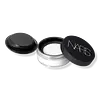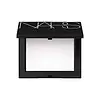NARS Cosmetics Light Reflecting Loose Setting Powder Versus NARS Cosmetics Light Reflecting Pressed Setting Powder
What's inside
What's inside
 Key Ingredients
Key Ingredients

 Benefits
Benefits

 Concerns
Concerns

 Ingredients Side-by-side
Ingredients Side-by-side

Silica
AbrasiveDimethicone
EmollientLauroyl Lysine
Skin ConditioningTrimethylsiloxysilicate
EmollientAscophyllum Nodosum Extract
Skin ConditioningGlycerin
HumectantMagnesium Silicate
AbsorbentTocopheryl Acetate
AntioxidantPolysilicone-2
Ethylhexylglycerin
Skin ConditioningWater
Skin ConditioningCitric Acid
BufferingCI 77120
Cosmetic ColorantAlumina
AbrasiveSea Water
HumectantChlorphenesin
AntimicrobialPotassium Sorbate
PreservativePhenoxyethanol
PreservativeIron Oxides
Mica
Cosmetic ColorantCI 77891
Cosmetic ColorantSilica, Dimethicone, Lauroyl Lysine, Trimethylsiloxysilicate, Ascophyllum Nodosum Extract, Glycerin, Magnesium Silicate, Tocopheryl Acetate, Polysilicone-2, Ethylhexylglycerin, Water, Citric Acid, CI 77120, Alumina, Sea Water, Chlorphenesin, Potassium Sorbate, Phenoxyethanol, Iron Oxides, Mica, CI 77891
Synthetic Fluorphlogopite
Silica
AbrasiveCetearyl Ethylhexanoate
EmollientGlycerin
HumectantSqualane
EmollientOctyldodecyl Stearoyl Stearate
EmollientPolysorbate 80
EmulsifyingCaprylyl Glycol
EmollientEthylhexylglycerin
Skin ConditioningChondrus Crispus Extract
Skin ConditioningXanthan Gum
Emulsifying1,2-Hexanediol
Skin ConditioningPentaerythrityl Tetra-Di-T-Butyl Hydroxyhydrocinnamate
AntioxidantSea Water
HumectantAscophyllum Nodosum Extract
Skin ConditioningMagnesium Silicate
AbsorbentTocopheryl Acetate
AntioxidantPhenoxyethanol
PreservativePotassium Sorbate
PreservativeTin Oxide
AbrasiveMica
Cosmetic ColorantCI 77891
Cosmetic ColorantCI 77491
Cosmetic ColorantCI 77492
Cosmetic ColorantCI 77499
Cosmetic ColorantSynthetic Fluorphlogopite, Silica, Cetearyl Ethylhexanoate, Glycerin, Squalane, Octyldodecyl Stearoyl Stearate, Polysorbate 80, Caprylyl Glycol, Ethylhexylglycerin, Chondrus Crispus Extract, Xanthan Gum, 1,2-Hexanediol, Pentaerythrityl Tetra-Di-T-Butyl Hydroxyhydrocinnamate, Sea Water, Ascophyllum Nodosum Extract, Magnesium Silicate, Tocopheryl Acetate, Phenoxyethanol, Potassium Sorbate, Tin Oxide, Mica, CI 77891, CI 77491, CI 77492, CI 77499
Ingredients Explained
These ingredients are found in both products.
Ingredients higher up in an ingredient list are typically present in a larger amount.
Ascophyllum Nodosum Extract is from brown seaweed that grows in the northern Atlantic Ocean. It is an antioxidant. Antioxidants help fight off free-radicals. Free-radicals are molecules that may damage our skin cells.
Ascophyllum Nodosum Extract is also used to enhance the texture of products.
Ci 77891 is a white pigment from Titanium dioxide. It is naturally found in minerals such as rutile and ilmenite.
It's main function is to add a white color to cosmetics. It can also be mixed with other colors to create different shades.
Ci 77891 is commonly found in sunscreens due to its ability to block UV rays.
Learn more about CI 77891Ethylhexylglycerin (we can't pronounce this either) is commonly used as a preservative and skin softener. It is derived from glyceryl.
You might see Ethylhexylglycerin often paired with other preservatives such as phenoxyethanol. Ethylhexylglycerin has been found to increase the effectiveness of these other preservatives.
Glycerin is already naturally found in your skin. It helps moisturize and protect your skin.
A study from 2016 found glycerin to be more effective as a humectant than AHAs and hyaluronic acid.
As a humectant, it helps the skin stay hydrated by pulling moisture to your skin. The low molecular weight of glycerin allows it to pull moisture into the deeper layers of your skin.
Hydrated skin improves your skin barrier; Your skin barrier helps protect against irritants and bacteria.
Glycerin has also been found to have antimicrobial and antiviral properties. Due to these properties, glycerin is often used in wound and burn treatments.
In cosmetics, glycerin is usually derived from plants such as soybean or palm. However, it can also be sourced from animals, such as tallow or animal fat.
This ingredient is organic, colorless, odorless, and non-toxic.
Glycerin is the name for this ingredient in American English. British English uses Glycerol/Glycerine.
Learn more about GlycerinWe don't have a description for Magnesium Silicate yet.
Mica is a naturally occurring mineral used to add shimmer and color in cosmetics. It can also help improve the texture of a product or give it an opaque, white/silver color.
Serecite is the name for very fine but ragged grains of mica.
This ingredient is often coated with metal oxides like titanium dioxide. Trace amounts of heavy metals may be found in mica, but these metals are not harmful in our personal products.
Mica has been used since prehistoric times throughout the world. Ancient Egyptian, Indian, Greek, Roman, Aztec, and Chinese civilizations have used mica.
Learn more about MicaPhenoxyethanol is a preservative that has germicide, antimicrobial, and aromatic properties. Studies show that phenoxyethanol can prevent microbial growth. By itself, it has a scent that is similar to that of a rose.
It's often used in formulations along with Caprylyl Glycol to preserve the shelf life of products.
Potassium Sorbate is a preservative used to prevent yeast and mold in products. It is commonly found in both cosmetic and food products.
This ingredient comes from potassium salt derived from sorbic acid. Sorbic acid is a natural antibiotic and effective against fungus.
Both potassium sorbate and sorbic acid can be found in baked goods, cheeses, dried meats, dried fruit, ice cream, pickles, wine, yogurt, and more.
You'll often find this ingredient used with other preservatives.
Learn more about Potassium SorbateSilica, also known as silicon dioxide, is a naturally occurring mineral. It is used as a fine, spherical, and porous powder in cosmetics.
Though it has exfoliant properties, the function of silica varies depending on the product.
The unique structure of silica enhances the spreadability and adds smoothness, making it a great texture enhancer.
It is also used as an active carrier, emulsifier, and mattifier due to its ability to absorb excess oil.
In some products, tiny microneedles called spicules are made from silica or hydrolyzed sponge. When you rub them in, they lightly polish away dead skin layers and enhance the penetration of active ingredients.
Learn more about SilicaTocopheryl Acetate is AKA Vitamin E. It is an antioxidant and protects your skin from free radicals. Free radicals damage the skin by breaking down collagen.
One study found using Tocopheryl Acetate with Vitamin C decreased the number of sunburned cells.
Tocopheryl Acetate is commonly found in both skincare and dietary supplements.
Learn more about Tocopheryl Acetate